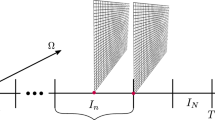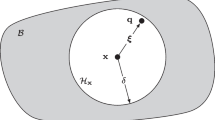Abstract
We describe a parallel algorithmic framework for optimizing the shape of elements in a simplicial volume mesh. Using fine-grained parallelism and asymmetric multiprocessing on multi-core CPU and modern graphics processing unit hardware simultaneously, we achieve speedups of more than tenfold over current state-of-the-art serial methods. In addition, improved mesh quality is obtained by optimizing both the surface and the interior vertex positions in a single pass, using feature preservation to maintain fidelity to the original mesh geometry. The framework is flexible in terms of the core numerical optimization method employed, and we provide performance results for both gradient-based and derivative-free optimization methods.


Similar content being viewed by others
References
Boman E, Bozda D, Catalyurek U, Gebremedhin A, Manne F (2005) A scalable parallel graph coloring algorithm for distributed memory computers. In: Cunha J, Medeiros P (eds) Euro-Par 2005 parallel processing, vol 3648., Lecture notes in computer scienceSpringer, Berlin, pp 241–251
DAmato J, Vnere M (2013) A CPUGPU framework for optimizing the quality of large meshes. J Parallel Distrib Comput 73(8):1127–1134
Fleurent C, Ferland JA (1996) Genetic and hybrid algorithms for graph coloring. Ann Oper Res 63(3):437–461
Freitag L, Jones M, Plassmann P (1999) A parallel algorithm for mesh smoothing. SIAM J Sci Comput 20(6):2023–2040
Freitag L, Knupp P, Munson T, Shontz S (2004) A comparison of inexact Newton and coordinate descent mesh optimization techniques. In: Proceedings of the 13th international meshing roundtable, Williamsburg, pp 243–254
Freitag L, Knupp P, Munson T, Shontz S (2006) A comparison of two optimization methods for mesh quality improvement. Invit Submiss Eng Comput 22(2):61–74
Freitag LA, Plassmann P (2000) Local optimization-based simplicial mesh untangling and improvement. Int J Numer Methods Eng 49(1–2):109–125
Garimella RV, Shashkov MJ, Knupp PM (2004) Triangular and quadrilateral surface mesh quality optimization using local parametrization. Comput Methods Appl Mech Eng 193(911):913–928
Gorman G, Southern J, Farrell P, Piggott M, Rokos G, Kelly P (2012) Hybrid OpenMP/MPI anisotropic mesh smoothing. Proc Comput Sci 9(0):1513–1522 (proceedings of the international conference on computational science, ICCS 2012)
Gyrfs A, Lehel J (1988) On-line and first fit colorings of graphs. J Graph Theory 12(2):217–227
Jiao X, Alexander P (2005) Parallel feature-preserving mesh smoothing. In: Gervasi O, Gavrilova M, Kumar V, Lagan A, Lee H, Mun Y, Taniar D, Tan C (eds) Computational science and its applications ICCSA 2005, vol 3483., Lecture notes in computer scienceSpringer, Berlin, pp 1180–1189
Jiao X, Bayyana NR (2008) Identification of c1 and c2 discontinuities for surface meshes in CAD. Comput Aided Des 40:160–175
Jones MT, Plassmann PE (1993) A parallel graph coloring heuristic. SIAM J Sci Comput 14(3):654–669
Lewis A, Overton M (2009) Nonsmooth optimization via BFGS. SIAM J Optim (submitted)
Liu A, Joe B (1994) Relationship between tetrahedron shape measures. BIT Numer Math 34(2):268–287
McLaurin D, Shontz S (2014) Automated edge grid generation based on arc-length optimization. In: Sarrate J, Staten M (eds) Proceedings of the 22nd international meshing roundtable, pp 385–403. Springer, New York
Montenegro R, Escobar J, Montero G (2005) Quality improvement of surface triangulations. In: Hanks B (ed) Proceedings of the 14th international meshing roundtable. Springer, Berlin, pp 469–480
Munson T (2005) Optimizing the quality of mesh elements. SIAG/Optim News Views 16:27–34
Munson T (2007) Mesh shape-quality optimization using the inverse mean-ratio metric. Math Program 110:561–590
Park J, Shontz SM (2010) Two derivative-free optimization algorithms for mesh quality improvement. Proc Comput Sci 1(1):387–396 (ICCS 2010)
Sastry S, Shontz S, Vavasis S (2014) A log-barrier method for mesh quality improvement and untangling. Eng Comput 30(3):315–329
Shaffer E, Cheng Z, Yeh R, Zagaris G, Olson L (2014) Efficient GPU-based optimization of volume meshes. In: Bader M (ed) Parallel computing: accelerating computational science and engineering (CSE). Advances in parallel computing, vol 25. IOS Press BV, Amsterdam, pp 285–294
Shaffer E, Zagaris G (2011) GPU accelerated derivative-free mesh optimization. In: Hwu W-M (ed) GPU computing gems jade edition. Applications of GPU computing series, chap 13, 1st edn. Morgan Kaufmann, Waltham, pp 145–154
Shewchuk J (2002) What is a good linear element? Interpolation, conditioning, and quality measures. In: Proceedings of the 11th international meshing roundtable, pp 115–126
Vartziotis D, Wipper J, Schwald B (2009) The geometric element transformation method for tetrahedral mesh smoothing. Comput Methods Appl Mech Eng 199(14):169–182
Volkov V, Kazian B (2008) Fitting FFT onto the G80 architecture, vol 40. University of California, Berkeley
Walton S, Hassan O, Morgan K (2013) Reduced order mesh optimisation using proper orthogonal decomposition and a modified cuckoo search. Int J Numer Methods Eng 93(5):527–550
Author information
Authors and Affiliations
Corresponding author
Rights and permissions
About this article
Cite this article
Cheng, Z., Shaffer, E., Yeh, R. et al. Efficient parallel optimization of volume meshes on heterogeneous computing systems. Engineering with Computers 33, 717–726 (2017). https://doi.org/10.1007/s00366-014-0393-7
Received:
Accepted:
Published:
Issue Date:
DOI: https://doi.org/10.1007/s00366-014-0393-7




